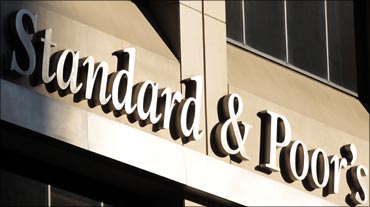Photographs: Reuters Lalit K Jha in Washington
Facing criticism inside the United States for downgrading America's credit rating from AAA to AA+, the Standard and Poor's Indian-American president Deven Sharma has said that the agency's decision was made mainly because of the rising debt levels and the process of resolving things.
"Our role is to call the risks objectively, with transparency, and that's what we try to do to fulfill our role and that's what our job is for the benefit of investors," Sharma told the CNBC news channel in an interview.
Going from AAA to AA+ rating, he argued, doesn't mean the US is going to default. "It just means its more risky today than a year ago."
. . .
Indian behind US downgrade SPEAKS out!
Image: Standard and Poor's Indian-American president Deven Sharma.Photographs: Reuters
The S&P, Sharma argued, factored in the political process of the United States in its calculation because it "speaks to how the fiscal, economic and monetary choices are being made."
"S&P's view was based on a number of factors including projections of rising debt levels," he asserted.
The S&P has been facing criticism in the United States after it downgraded its credit rating. In fact top American leadership have been questioning its credibility.
. . .
Indian behind US downgrade SPEAKS out!
Photographs: Reuters
Sharma said he is pleased by President Barack Obama's speech in which he addressed the need for US lawmakers to have a new sense of urgency to tackle long-term deficit spending.
Acknowledging that S&P committed mistakes that played a part in the sub-prime mortgage crisis, Sharma said the credit rating agency has learned lessons from its past mistake.
"Clearly the housing declines were much more severe than we forecast or anticipated," Sharma said.
. . .
Indian behind US downgrade SPEAKS out!
Photographs: Reuters
S&P has made many changes in putting new checks and balances in the organisation.
"We are committed to the reform process," Sharma said. He argued that S&P's decision is not solely responsible for the drop in the US market, adding that stock markets are determined by a number of factors, sometime many of which are unexplainable.
"The market could be reacting to the fact there is a slowdown in economic growth. It could be reacting to what's happening in Europe. It could be what's happening in the US. There are multiple factors that...contribute to how the market reacts," Sharma added.
. . .
Indian behind US downgrade SPEAKS out!
Photographs: Reuters
Number of defaults on debt payments tripled in Q2: S&P
The number of defaults on debt payments by companies that were certified by credit ratings agencies tripled in the second quarter of 2011 in comparison to the first quarter, a new article published by Standard & Poor's Global Fixed Income Research has said.
According to the report, globally, 15 companies (13 public and two confidentially rated) defaulted in the second quarter of 2011.
The volume of rated debt affected by defaulters in the second quarter was $39.5 billion, up from five defaults in the first quarter with $3.6 billion in debt, the research paper, titled, 'Quarterly Global Corporate Default Update And Rating Transitions', said.
. . .
Indian behind US downgrade SPEAKS out!
Photographs: Reuters
Of the 15 defaults in the second quarter of 2011, eight were domiciled in the US, two in Canada, two in New Zealand, and one each in the UAE, Russia, and France.
"On a trailing-12-month basis, the global speculative-grade default rate as of June, 2011, was 2 per cent, down slightly from 2.08 per cent at the end of March and 5.12 per cent at the same time in 2010," said Diane Vazza, the head of Standard & Poor's Global Fixed Income Research division.
"The default rate is now at its lowest point since August 2008, the last reading prior to the collapse of Lehman Brothers and the ensuing recession in the US.
. . .
Indian behind US downgrade SPEAKS out!
Photographs: Reuters
"Overall, credit quality has, in our view, continued to stabilise over the past 18 months, as the number of downgrades has decreased slightly across all regions," said Vazza.
"The downgrade-to-upgrade ratio fell to 0.64 per cent in the second quarter of 2011 from 1.10 per cent in the previous quarter," she said.
The decrease from the first quarter is the result of a slight uptick in upgrades -- to 3.5 per cent from 2.45 per cent -- along with a decrease in downgrades to 2.25 per cent from 2.7 per cent.








article